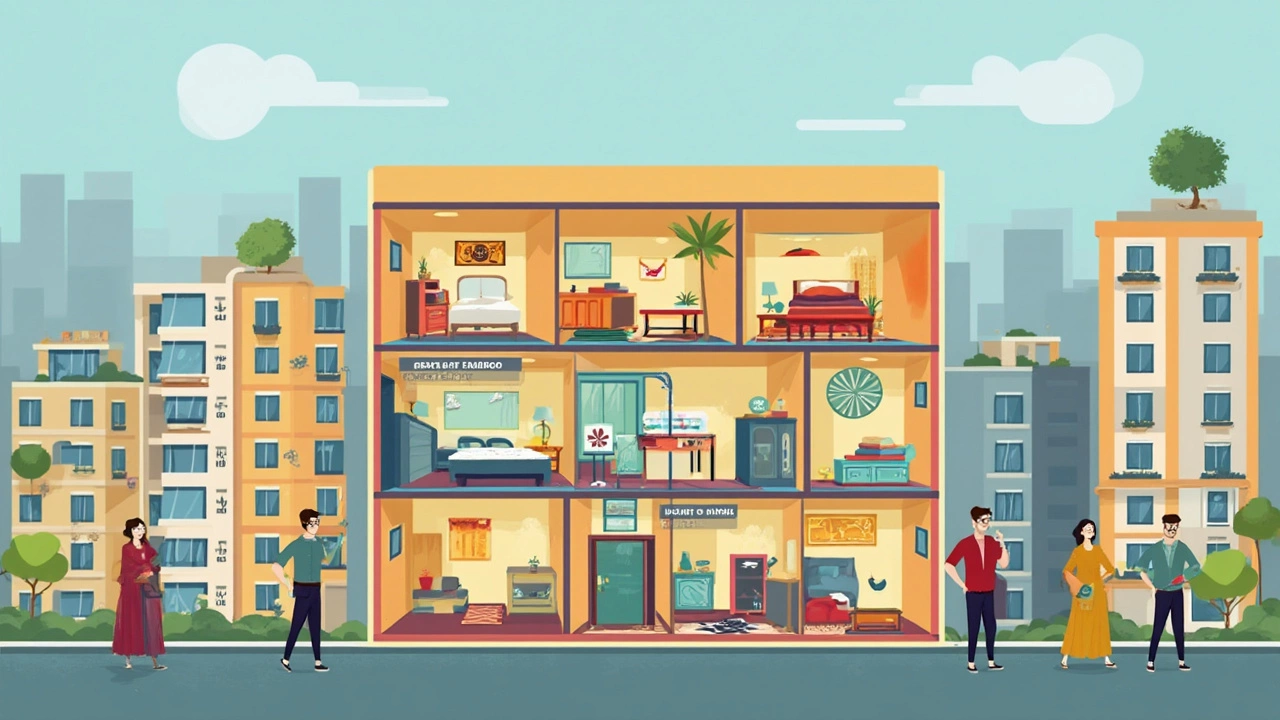Ever measured out a bedroom and wondered, is this actually allowed? The legal minimum size for a bedroom is not just some random number—most places in the U.S. stick with about 70 square feet (like a room 7 feet by 10 feet). But it’s not always this simple. Cities tweak these numbers all the time. If you’re in New York or Chicago, expect stricter rules than you find in the suburbs.
Why does this matter for 2BHK apartments? You might be converting a dining nook or carving out a second bedroom to fit your needs—or maybe you’re eyeing a listing that seems suspiciously tiny. That minimum number isn’t just about squeezing in a mattress and calling it a day. If it’s not legal, you can’t use it as a bedroom on official docs or rental listings. Lenders, renters, and buyers care. If your room doesn’t measure up, it might even make your home harder to sell.
- Legal Minimums for Bedroom Size—By The Numbers
- Why These Rules Matter in 2BHK Apartments
- Smart Design Hacks for Small Bedrooms
- Big Problems With Too-Small Bedrooms
Legal Minimums for Bedroom Size—By The Numbers
If you’re trying to check if your room cuts it as a legal bedroom size, here’s what you need to know: Most building codes in the U.S. say a bedroom must be at least 70 square feet. That usually means the smallest legal bedroom is around 7 feet by 10 feet. This rule is pretty much the baseline, but it’s smart to check your local city or state code because there can be stricter rules or sneaky extra conditions.
It’s not just about square footage. The law often says a bedroom must be at least 7 feet in any direction. Closet space isn’t required everywhere, but in most newer buildings, it’s expected. As for height, a bedroom usually needs a ceiling height of at least 7 feet for most of the room. That means no claiming that crawl space or attic bump-out as a bedroom, even if you can fit a mattress in there!
Here’s a quick look at what you’ll find in some big cities:
| City | Min. Area (sq. ft.) | Min. Width (ft.) |
|---|---|---|
| New York, NY | 80 | 8 |
| San Francisco, CA | 70 | 7 |
| Chicago, IL | 70 | 7 |
There’s also the stuff about windows. Bedrooms need a window for natural light and emergency exits (sometimes called egress), which is a big deal for safety and can totally rule out using a basement as a real bedroom.
If you’re checking a listing for a 2BHK apartment and one of the rooms looks tiny, measure it and double-check the local code. Some landlords or sellers get creative with their descriptions, but banks and city inspectors don’t mess around with these rules. If you get it wrong, you could hit problems with permits or resale value down the road.
Why These Rules Matter in 2BHK Apartments
Here’s the deal: bedroom size isn’t just a matter of comfort. It’s about legality and your wallet, too. When you buy or rent a 2BHK apartment, both bedrooms have to hit the legal minimum size to officially count. If they don’t, you’re looking at issues with loans, resale value, and even how many people can legally live in the apartment.
Some local codes go beyond square footage—they also check window size, closet space, and even ceiling height. For example, New York City’s Housing Maintenance Code sets the bar at 80 square feet for a legal bedroom, and the room usually needs at least one window that opens to outside air. In many cities, bedrooms must also fit a minimum width—often 7 feet.
If you’re trying to convert a study or small alcove to a second bedroom in your 2BHK, know this: you can’t just slap up drywall and call it done. If your space is under the legal requirement, it won’t show up as a bedroom when appraisers or inspectors come by. Banks rely on those legal numbers to determine your mortgage, and you can’t market a two-bedroom if one space breaks the code.
Landlords risk even more. Renting out a too-small room as a "bedroom" can lead to fines—sometimes thousands of dollars. Your insurance might not cover accidents or damages in an illegal bedroom. Plus, tenants can break the lease if they find out the room isn’t legal, no matter how good your ad looked.
Here’s a quick look at how rules differ by city:
| City | Minimum Bedroom Size | Other Key Requirements |
|---|---|---|
| New York City | 80 sq ft | At least one window, 8 ft ceiling |
| Chicago | 70 sq ft | 7 ft width, window and closet required |
| Los Angeles | 70 sq ft | Separation from kitchen, natural light |
It all comes down to this: for apartment rules to work in your favor, make sure every bedroom meets that legal size. Skip this, and you could be facing big setbacks—the kind that mess with your mortgage, ability to rent, or even a simple resale down the road.

Smart Design Hacks for Small Bedrooms
You don’t need a giant room to make it work as a legit bedroom. Clever design can turn even the legally smallest bedroom size into a space you’ll actually want to spend time in. The goal is to free up floor space, keep things tidy, and make your room feel bigger than it is.
- Go Vertical: Tall shelving and wall-mounted storage save a ton of space. Store books, decor, or even clothes up top to keep the floor clear.
- Multi-Function Furniture: Look for beds with drawers underneath or a desk that folds away. In 2BHKs, these double-duty pieces can be a game changer.
- Keep it Light: Stick with light wall colors and simple window treatments. Small bedrooms with lots of natural light and pale walls just feel less cramped. Mirrors help too by bouncing light and faking more space.
- Don’t Overload: Be strict about what comes into the room. If you don’t use it, ditch it. Too much furniture makes the minimum legal requirements feel even tighter.
Here’s a quick look at how some classic small bedroom hacks pay off:
| Hack | Avg. Space Saved |
|---|---|
| Wall shelves vs. bookcase | 2-4 sq. ft. |
| Under-bed drawers vs. dresser | 4-6 sq. ft. |
| Murphy bed vs. regular bed | 10-12 sq. ft. |
When your bedroom is barely clearing that legal minimum, every inch counts. Swapping even one regular dresser for under-bed storage or shelves can help you avoid bumping into stuff every time you walk in. And don’t underestimate good habits—keeping clutter out of a small room instantly opens it up.
Big Problems With Too-Small Bedrooms
If a bedroom doesn’t hit that legal minimum bedroom size, it can mess things up in ways most people don’t expect. You might think, “I’ll just squeeze a twin bed in here,” but city codes don’t care how creative you get with your layout. You need enough room for safe movement and emergency exits, and ignoring those rules can cost you.
Here’s the stuff that really matters:
- Resale Value Tanks: Buyers and banks both go by legal specs. If your room is too small, some lenders might not even count it as a real bedroom, killing your home’s value as a 2BHK. “Lenders often require each bedroom to meet local code before they’ll approve a mortgage,” warns home appraiser Jake Elliot.
- Renting Gets Risky: If you rent out a space that doesn’t count as a bedroom by city standards, you could land in legal hot water. Tenants can actually break their lease and walk if the room is illegally small—and sometimes you could face fines.
- Safety Issues: Small rooms get packed fast. When blocked exits or windows don’t meet code, it’s not just a ticket at stake—it’s your safety. The National Fire Protection Association says rooms that don’t provide a 7-foot horizontal measurement don’t count as viable sleeping rooms in case of fire.
And here’s a quick look at how bedroom size rules show up in the real world:
| City | Minimum Sq. Ft. | Extra Rules |
|---|---|---|
| New York City | 80 | Must fit a window |
| Los Angeles | 70 | 7 ft. horizontal measurement |
| Chicago | 70 | Must allow for exit door + window |
“Space isn’t just a matter of comfort. It’s a matter of compliance, safety, and, at the end of the day, value.” — Building Inspector Melinda Torres
So if you're looking at a 2BHK apartment, double check those measurements before calling a room a bedroom. It’s not about simply squeezing in a bed—it’s about meeting rules that actually matter for your safety and investment.

